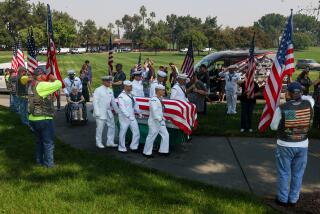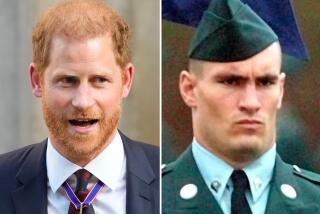Message Received
- Share via
SAN JOSE — It is a day of barbecues and water-skiing, a day when our Fourth of July independence is medium rare and glassy smooth.
That’s why Pat Tillman went to Afghanistan.
His life was nicely marinated and mostly free of ripples. His freedom was a given, his future and that of his family unthreatened -- until two planes flew into the World Trade Center and another into the Pentagon. The rest of us gasped and fretted. Tillman acted.
The story is not new. Nor is it any less amazing. He was an honor student and star football player from San Jose who went to Arizona State and became an honor student and star football player. He went on to become a star defensive back with the Arizona Cardinals in the NFL. Then he left it all, including a multimillion-dollar contract, saying that members of his family had traditionally served in the military, that his grandfather had been at Pearl Harbor, “and I really haven’t done a damn thing.”
We liked him before that. The long hair that flowed from under his helmet set him apart, but not any more than his disdain for showy, material things or for shallow questions from sportswriters. Those questions were greeted by a raised eyebrow and a slight frown that meant he thought they lacked substance, something he never did.
It has been two years, two months and 12 days since he died in Afghanistan. We grill our meat, ride our skis, sit on our beaches and assume that there will always be another Pat Tillman, another shield. The military, as embattled and besieged as it is today, is full of heroes to be celebrated on this day of patriotism. We have civilian heroes in every phase of life, putting out fires and standing in crosswalks so 6-year-olds can pass safely.
But there was only one Pat Tillman, and the world of sports, which generates more swaggering pretend heroes per capita than perhaps any other phase of American life, may never see another like him. Tillman didn’t swagger and would have hated being called a hero.
Alex Garwood is Tillman’s brother-in-law. His wife, Christine, is the sister of Tillman’s widow, Marie. Garwood is also the executive director of the Pat Tillman Foundation, which exists, according to the foundation’s website, “to carry forward Pat’s legacy by inspiring and supporting young people striving to promote positive change in themselves and the world around them.” Garwood says the foundation programs are going well because of “the power of Pat.” To the foundation, and Tillman’s friends and family, that is a given, not a motto.
“He had it, whatever it was,” Garwood says. “He was the kind of man who walked into a room and everybody noticed. People wanted to be close to it, to rub up against it and hope some rubbed off.”
Garwood says he never thinks of Tillman in uniform, either football or military.
“I think of him as my friend, sitting with me, having iced tea and talking. He was the best listener I knew.”
And the least full of himself.
“When Pat was with the Cardinals,” Garwood says, “people he’d run into would ask him what he did? He would tell them he worked in Arizona.”
Garwood and Tillman were hiking alongside a river near Sedona, Ariz., five or six years ago when Tillman suggested they walk the middle of the shallow river, rock to rock, without getting their shoes wet.
“We ended up going a mile, maybe more,” Garwood recalls. “I was soaked. He never got a drop on his shoes. The amazing thing wasn’t just his athleticism, but watching his mind work as he figured out each next step and how best to do it.”
When they finished, Tillman climbed a cliff about two stories high and, to get back down, leaped from the top of the cliff to a tree, 10 feet away, and calmly climbed down.
“The rest of us have trepidation,” Garwood says.
It is possible that, on that April 22, 2004, in Afghanistan, even Pat Tillman had trepidation. He died a horrible death, at the hands of his fellow Army Rangers, who apparently were confused and frightened and fired at what they thought was the enemy, rather than somebody they had idolized, somebody they’d watched hand out $5 bills to youngsters in the dusty poor towns of Afghanistan, somebody who’d bought and brewed special coffee blends for them so they could have the best.
Tillman’s platoon was split, one part ending up firing on the other, Tillman’s group in the hills. Not far from the group doing the firing was Tillman’s brother, Kevin, who didn’t learn that his brother had died until nearly an hour later.
It took a month before the Tillman family was told the truth, although they’re still not sure they have it all. Their son had not died from enemy fire, but friendly fire. The military calls that “fratricide.”
It has taken several years for journalists, especially those from the San Francisco Chronicle, the Washington Post, CNN and The Times’ David Zucchino, to unearth and report the stunning details of what happened and how the truth was stonewalled and turned into a mockery by the U.S. military.
On Dec. 6, 2004, Zucchino wrote: “Pat Tillman died in the dark, between two black boulders, halfway up a canyon wall, just below the mud farmhouse of Zamir Jan. To Jan, Tillman was just another American stranger. But to millions of people a world away, who watched Tillman give up a lucrative professional football contract to fight for his country, his death was an American tragedy.”
Last May 29, CNN.com reported the testimony of the unnamed soldier who had been standing next to Tillman when the shooting began.
“Tillman and I were yelling, ‘Stop! Stop! Friendlies! Friendlies! Cease Fire!’ But they couldn’t hear us.”
(Tillman threw a smoke grenade to signal that they were Rangers, and for a few moments, it appeared to work.)
“We thought the battle was over, so we were relieved, getting up and stretching out and talking with one another, when I heard some 5.56 rounds coming from the vehicle. They started firing again. That’s when I hit the deck and started praying.”
(But Tillman didn’t get down in time. He was hit, reportedly taking shrapnel in the wrist and body armor.)
“I know this because I could hear the pain in his voice as he called out: ‘Cease fire! Friendlies! I am Pat ... Tillman, damn it.’ He said this over and over again until he stopped.”
(Moments later, a sound caught the attention of the soldier next to Tillman.)
“I heard what sounded like water pouring down. I then looked over at my side to see a river of blood coming down from where he was. I had blood all over my shoulder from him and when I looked at him, I saw his head was gone.”
For a while, Garwood’s garage here in San Jose was packed with memorial gifts from people all over the country. There is at least one item from each of the 50 states.
There are military medals, even others’ Purple Hearts. There are flags, some from Camp Tillman in Afghanistan, named after he died. There are teddy bears, photos of babies named after him, trophies from youth football teams that dedicated their season to him and sent along the symbols of their success, combat boots, even a football signed by a group of prison inmates who vowed, in the name of Pat Tillman, to be better people.
Garwood has it all in storage now, respecting each item but, more than two years later, not quite certain what to do with it. He remains, it appears, with the rest of the Tillman family, in a limbo of anger, grief, resolve and numbness.
For the rest of us, we have the terrible details, which bring us disgust. We also have a clear picture of the man, which brings us undying admiration, and perhaps some closure.
Some of us also have the independence to write about this in whatever way we wish. For which we thank, among so many heroes, Pat Tillman.
*
Bill Dwyre can be reached at
[email protected]. To read previous columns by Dwyre, go to latimes.com/dwyre.
More to Read
Go beyond the scoreboard
Get the latest on L.A.'s teams in the daily Sports Report newsletter.
You may occasionally receive promotional content from the Los Angeles Times.











